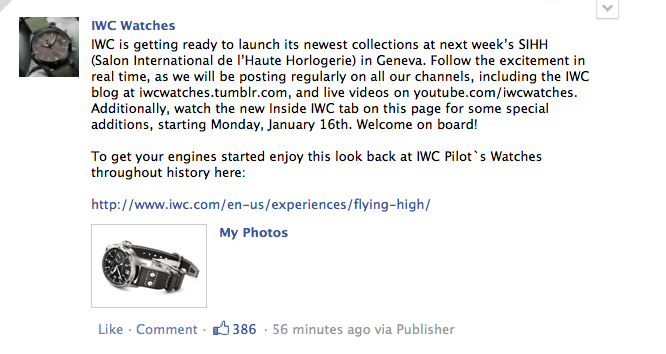Flying High - by Michael Friedberg
It’s no flight of fancy that IWC Pilot’s Watches have become icons. Exceedingly popular, they represent IWC values, defining the entire genre of pilot’s watches within the Swiss watch industry. There is perhaps no other company in the entire watch industry with as rich a heritage for aviators timepieces. In the 21st century, the design and attributes of these watches have made IWC an industry leader.
IWC’s authentic history as a manufacturer of pilot’s watches evokes the alluring romance of adventure. Early aviators had courage as they literally defied gravity. And, today, in the age of supersonic jets launched from aircraft carriers there is a thrill hearing the sound, sensing the speed and almost feeling the g-force. The pilot must be perfect in every maneuver.
The watches of aviators have always been highly functional tools. They are relied on to be absolutely precise as they define time and, accordingly, speed and distance.
This history, adventure and precision have all been embedded in IWC’s DNA for almost eight decades. Around 1936, IWC produced its first “special watch for aviators”. Then, in 1940, using a specially-modified pocket watch movement, IWC produced its now famous oversized “Big Pilot” watch for navigational use by the German Air Force. And, in 1948, IWC introduced the legendary Mark 11 for the British Royal Air Force and for other Commonwealth militaries. In all instances, these watches bore black dials with bold, luminous white Arabic numerals that were clearly legible at a glance in the cockpit.

Pilot's Watch Mark 11 (1948)
As “tool watches”, these vintage pilots watches were designed for function. They were extraordinarily durable, perfectly accurate and easy to read. Although some “military-style” dials were also used in civilian watches, they were neither designed nor marketed for fashion. Intriguingly, they have become popular fashion statements for countless consumers over the past 20 years.
The popularity of military-style watches for civilians probably was reborn in 1988, when IWC debuted its reference 3740, a “semi-mechanical” pilot’s chronograph. That watch contained a movement that combined quartz power with a mechanical chronograph. It had a utilitarian military-style dial on a fine steel watch.
It presumably was not known then that IWC reference 3740 would spawn an entire generation of Pilot’s Watch models, and would define anew what aviator watches meant. In the early 1990s, IWC then introduced a Pilots’ Watch with a fully mechanical chronograph movement, as well as a split-seconds “Doppelchronograph” Pilot’s Watch. It also produced its Mark XII model, which was a successor to the legendary military Mark 11 updated with an automatic movement and date. These all were luxury timepieces, finely-crafted mechanical instruments, but they were also tool watches. Usually in steel cases, they had clear military-styled dials which proved that their essence was function.
The renewed style took the public by storm. Consequently, over the past 15 years IWC introduced many more aviator’s timepieces. These included a two timezone “UTC” model, with an ingenious module designed by IWC’s legendary watchmaker, Kurt Klaus. Perhaps foremost was the 2002 introduction of reference 5002, the IWC Big Pilot’s Watch, which was a modern reinterpretation of the IWC 1940 military watch. At a fraction over 46 millimeters, the “Big Pilot” was one of the largest made then by the entire Swiss watch industry. It evolved to the reference 5004 IWC Big Pilot’s Watch, and also was used as the base for numerous special editions as well as special perpetual calendar Pilot’s Watch models.

Big Pilot's Watch (2002)
All these watches became best sellers. While initially the oversized “Big Pilot” was considered large, today it is a signature model for IWC. Moreover, it marshaled the trend toward larger watches being fashionable. A trendsetter for the industry, it exudes a brash superiority not just with its size but also its function.
In 2012, IWC continues this trend with new Pilot’s Watches, especially its Top Gun Miramar models, an IWC World Timer Watch and redesigned Spitfire models with a new Calibre 89365 chronograph movement. These novelties reflect aesthetic and technical prowess. Also special is the new Spitfire Perpetual Calendar Digital Date-Month with chronograph.

Pilot's Watch Chronograph TOP GUN Miramar
Ironically, these well-executed flight watches will mostly be used by consumers who are not pilots. Most all have not been, nor will be, flown other than on the wrist of a passenger in or out of a commercial aircraft. Today, navigational instruments are generally electronic, and the array of computerized tools available to modern pilots means that pilots’ watches are partially anachronisms.
Yet this may be the greatest innovation of these models. They take the concept of tool watches and their illustrious heritage and transport that to useful instruments in this century. We appreciate these watches for their precision, for their symbolism, and for their use as precise timing devices. Their durability, their romance and their utility enhance our lifestyle.
IWC has been an industry leader also by causing us to consider more fully what makes a fine watch. The Pilot’s Watches are fine watches because of what they represent. They are essentially “sound minds in sound bodies”: great technical mechanics encased with something strong, resilient and legible.
These watches follow the Bauhaus-dictum of form following function. The Pilot’s Watches are the epitome of that principle, and IWC’s leading role in advocating that may be its finest hour.
